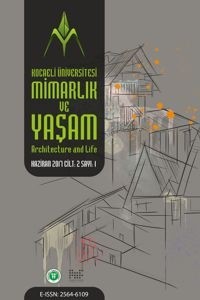Anadolu’da Neolitik Dönem’de Mimarlığın Temel İlkeleri Üzerine Bir Araştırma
Neolitik Dönem, Mimarlığın Temel İlkeleri, Mimarlık
A Study On The Principles Of Architecture In The Neolithic Period In Anatolia
Neolithic Period, The Principles of Architecture, Architecture,
___
- Aktüre, S. (1994a). Anadolu’da Bronz Çağı kentleri. Tarih Vakfı. Retrieved from https://www.idefix.com/kitap/anadoluda-bronz-cagi-kentleri/sevgi-akture/bilim/arkeoloji/urunno=0000000056807
- Aktüre, S. (1994b). Anadolu’da Bronz Çağı kentleri. Tarih Vakfı.
- Alberti, L. B. (1905). The Ten Books of Architecture. Dover Publications.
- Aldendenfer, M. (1993). Ritual, hierarchy, and change in foraging societies. Journal of Anthropological Archaeology, 12, 1–40.
- Braidwood, R. (1995). Tarihöncesi İnsan (çev. B. Altınok). İstanbul: Arkeoloji ve Sanat Yayınları, Deneme Eleştiri ve Tarih Dizisi: 14.
- Childe, V. G. (n.d.). What Happened in History (10th ed.). London: Pelican Books, C. Nicholls & Company Ltd Press.
- Childe, V. G. (1947). Social Evolution. London: WATTS & CO. Retrieved from https://archive.org/details/in.ernet.dli.2015.105479
- Childe, V. G. (1951). Man Makes Himself (13th ed.). New York: Mentor Book Series, The New American Library Inc. Press.
- Childe, V. G. (1957). New Light on the Most Ancient Easte (3rd ed.). New York: Grove Press.
- Ching, F. D. K. (2014). Mimarlık: Biçim, Mekan, Düzen (çev: S. Lökçe) (6th ed.). İstanbul: YEM Yayın.
- Eksen, Z. (2010). Antik Çağda Ağırlık ve Hacim Ölçü Araçları. Akdeniz Üniversitesi.
- ERDOGU, B., & ULUBEY, A. (2011). COLOUR SYMBOLISM IN THE PREHISTORIC ARCHITECTURE OF CENTRAL ANATOLIA AND RAMAN SPECTROSCOPIC INVESTIGATION OF RED OCHRE IN CHALCOLITHIC ÇATALHÖYÜK. Oxford Journal of Archaeology, 30(1), 1–11. https://doi.org/10.1111/j.1468-0092.2010.00356.x
- Esin, U. (1994a). Akeramik Neolitik Evrede Aşıklı Höyük. Ankara: Türk Tarih Kurumu. Retrieved from http://www.asiklihoyuk.org/wp-content/uploads/2017/10/Esin-1994a.pdf
- Esin, U. (1994b). Akeramik Neolitik Evrede Aşıklı Höyük. Ankara: Türk Tarih Kurumu.
- Gadol, J. K. (n.d.). Leon Battista Alberti. Retrieved July 18, 2018, from https://www.britannica.com/biography/Leon-Battista-Alberti
- Güngör, H. (1972). Temel Tasar (1st ed.). İstanbul: Çeltüt Matbaacılık Koll. Şti.
- Hauptmann, H. (1999). The Urfa Region. In M. Özdoğan & N. Başgelen (Eds.), Neolithic in Turkey, The Cradle of Civilization, New Dİicovries (pp. 65–89). İStanbul: Arkeoloji ve Sanat Yayınları.
- Hauptmann, H. (2007). Nevali Çori ve Urfa Bölgesinde Neolitik Dönem. In M. ÖZdoğan & N. Başgelen (Eds.), Anadolu’da Uygarlığın Doğuşu ve Avrupa’ya Yayılımı, Türkiye’de Neolitik Dönem, Yeni Kazılar, Yeni Bulgular (pp. 131–164). İstanbul: Arkeoloji ve Sanat Yayınları.
- Hodder, I. (2006). Çatalhöyük: the Leopard’s Tale, Revealing the Mysteries of Turkey’s Ancient ‘Town. London: Thames and Hudson.
- Hovers, E., Ilani, S., Bar‐Yosef, O., & Vandermeersch, B. (2003). An Early Case of Color Symbolism. Current Anthropology, 44(4), 491–522. https://doi.org/10.1086/375869
- Knight, C., Power, C., & Watts, I. (1995). The Human Symbolic Revolution: A Darwinian Account. Cambridge Archaelogical Journal, 5(1), 75–114.
- Kolankaya-Bostanci, N. (2012). ANADOLU’DA ERKEN PREHSTORK DÖNEM KIRMIZI AI BOYASI KULLANIMI. Anadolu / Anatolia, 38, 29–51. Retrieved from http://dergiler.ankara.edu.tr/dergiler/14/1790/18888.pdf
- Mellaart, J. (1967a). Catal-huyuk. A Neolithic Town In Anatolia. New York: McGraw-Hill Book Company. Retrieved from https://archive.org/details/Catal-huyuk.ANeolithicTownInAnatolia
- Mellaart, J. (1967b). Catal-huyuk. A Neolithic Town In Anatolia. New York: McGraw-Hill Book Company.
- Mellaart, J. (1970). Excavations at Hacılar. Edinburg: British Institute at Ankara, Edinburgh University Press.
- Melvin, J. (2005). İzmler: Mimarlığı Anlamak (çev. M. Şahin) (1st ed.). İstanbul: YEM Yayın.
- Özdoğan, A. (1994). Çayönü Yerleşmesinin Çanak Çömleksiz Neolitikteki Yeri. İstanbul Üniversitesi.
- Özdoğan, M., & Özdoğan, A. (1998). Buildings of Cult and the Cult of Buildings. In A. Güven, M. J. Mellink, & W. Schirmer (Eds.), Karatepe’deki Işık: Halet Çambel’e Sunulan Yazılar (pp. 581–593). İstanbul: Ege Yayınları. Retrieved from http://www.academia.edu/9962655/Buildings_of_Cult_and_the_Cult_of_Buildings
- Özdol, S. (2011). Çanak Çömleksiz Neolitik Çağda GÜneydoğu Anadolu’da Din ve Sosyal Yapı. Tarih İncelemeleri Dergisi, 26, 182(2), 179, 181, 182–183.
- Özyarkent, H. (2007). Yakındogu’da Yerlesik Yasamın Baslangıcı ile İlgili İlk Kuramlar ve Bunların Alan Çalışmalarını Yönlendirici Etkileri V. G. Childe ve R.J. Braidwood’un Görüsleri ve Arkeolojik Çalışmalara Etkisi. İstanbul Teknik Üniversitesi.
- Petru, S. (2006). Red, black or white? The dawn of colour symbolism. Documenta Praehistorica, 33, 203–208. https://doi.org/10.4312/dp.33.18
- Rosenberg, M. (2007). Hallan Çemi. In M. Özdoğan & N. Başgelen (Eds.), Anadolu’da Uygarlığın Doğuşu ve Avrupa’ya Yayılımı, Türkiye’de Neolitik Dönem, Yeni Kazılar, Yeni Bulgular (pp. 1–11). İstanbul: Arkeoloji ve Sanat Yayınları.
- Roth, L. M. (2014). Mimarlıǧın Öyküsü : Öǧeleri, Tarihi ve Anlamı (çev. E. Akça ). İstanbul: Kabalcı Yayınevi. Retrieved from http://www.dr.com.tr/Kitap/Mimarligin-Oykusu/Sanat-Tasarim/Mimari/urunno=0000000078394
- Ruskin, J. (1889). The Seven Lamps of Architecture (6th ed.). Sunnyside, Orpington, Kent: George Allen.
- Schirmer, W. (1981). Zur Ausbildung der Bautypen des Çayönü Tepesi. In IX. Türk Tarih Kongresi, 21-25 Eylül 1981, Ankara (I. Cilt) (pp. 41–51). Ankara: Türk Tarih Kurumu.
- Schmidt, K. (2006). Ritual Centers“ and the Neolithisation of Upper Mesopotamia. In O. Gebel, H., G., K., Rollefson, G. (Ed.), NEO-LITHICS 2/05 The Newsletter of Southwest Asian Neolithic Research Editorial Dialogue The Early Neolithic Origin of Ritual Centers (pp. 13–21). Retrieved from https://www.exoriente.org/docs/00050.pdf
- Shrimpton, N. (n.d.). John Ruskin. Retrieved July 22, 2018, from https://www.britannica.com/biography/John-Ruskin
- Sümer, G. (2007). Anadolu’da Neolitik Dönemde Tanrı ve Taanrıça. Ege Üniversitesi.
- Türkcan, A. U. (2006). Çanak Çömleksiz Neolitik Dönemde Yukarı Neolitik Mezopotamya Anıtsal Kült Binaları ve Gelişimi. Hacettepe Üniversitesi, Ankara.
- Ülger, S. (2007). Yakındoğu İlk Neolitik Kültürlerinde Yapı Kültü ve YapılarınGömülme Sorunu. İstanbul Üniversitesi.
- Vitruvius. (1993). Mimarlık Üzerine On Kitap (çev. S. Güven) (2nd ed.). İstanbul: Şevki Vanlı Mimarlık Vakfı Yayınları.
- Wright, G. A. (1971). Origins of Food Production in Southwest Asia: A Survey of Ideas. Current Antropology: A World Journal of Sciences and Man (The University of Chicago Press), 12(4–5), 448, 452.
- ISSN: 2564-6109
- Başlangıç: 2016
- Yayıncı: Kocaeli Üniversitesi
Kullanıcı Beklentilerinin Modern Bir Cami Örneği Üzerinden İncelenmesi
Sena IŞIKLAR BENGİ, Abdurrahman Yağmur TOPRAKLI
Cambridge Camisi’nin Düşündürdükleri
Sinematik Kurgunun Bilinçaltı Mekânları-Tekinsiz Mekânlar
Farklı Bakış Açılarıyla Sürdürülebilir Mimarlık-Estetik İlişkisinin Kurulması
Demet YILMAZ YILDIRIM, Kader KESKİN
İzmit Tarihi Yeni Hamam Restorasyon Projesi: Yapısal Değerlendirme
Kırsal Yaşamın Mimari Göstergesi Geleneksel Köy Evlerinin Düzce Örnekleminde Tartışılması
Gotik Mimari ve Skolastik Felsefe İlişkisi Üzerine Bir Deneme
Kahramanmaraş'ta Bir Erken Cumhuriyet Dönemi Evi: Çiftarslan Evi
Trabzon Kent Merkezinin Göstergebilim Yaklaşımı İle Okunması
Funda KURAK AÇICI, Elif SÖNMEZ
Anadolu’da Neolitik Dönem’de Mimarlığın Temel İlkeleri Üzerine Bir Araştırma
